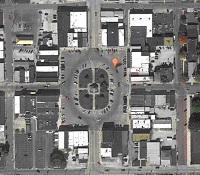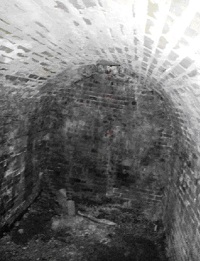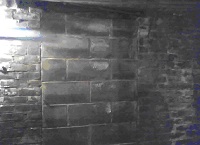
 For at least the two
decades I’ve lived in Carlinville, rumors of mysterious tunnels under the town
have abound. Many versions exist. Some cite explanations that are not at all
interesting. Others envision a whole, complex, underground network. Of the
note-worthy renditions, the basic story starts with tunnels that connect some or
all of the buildings around the town square. Some versions build on to that with
tunnels connecting the square to the courthouse, the courthouse to the old jail,
the square to the Anderson Mansion, and the square to most or all of East Main
Street. Other stories make reference to a gangster tunnel from the American
Legion Park ballfield to the vicinity of the Assembly of God, where “Al Capone’s
car is buried under a barn” (suggesting this was a “drive-thru tunnel”). Others
mention “beer caves” near the Rt-4/Rt-108 intersection.
For at least the two
decades I’ve lived in Carlinville, rumors of mysterious tunnels under the town
have abound. Many versions exist. Some cite explanations that are not at all
interesting. Others envision a whole, complex, underground network. Of the
note-worthy renditions, the basic story starts with tunnels that connect some or
all of the buildings around the town square. Some versions build on to that with
tunnels connecting the square to the courthouse, the courthouse to the old jail,
the square to the Anderson Mansion, and the square to most or all of East Main
Street. Other stories make reference to a gangster tunnel from the American
Legion Park ballfield to the vicinity of the Assembly of God, where “Al Capone’s
car is buried under a barn” (suggesting this was a “drive-thru tunnel”). Others
mention “beer caves” near the Rt-4/Rt-108 intersection.
To-date, this
investigation has turned up precious few facts, but one thing is undeniably
true … rumors of tunnels have been, are, and likely always will be, an enduring
element of local lore.
Confirmed Facts
1) Rumors of tunnels are
very well-established. Most folks are rock-solid in their belief that the
tunnels exist. No evidence of proof seems to exist, despite some known past
effort to find it. Seeking the truth about these tunnels is like chasing ghosts.
There is virtually nothing specific to be found on the internet.
2) The
age of the town square buildings needs to be better defined for each structure,
still, it's safe to say they date back to around the 1800's. This certainly
coincides with the use of coal for heating buildings, and it coincides with the
Prohibition years. Some rumors allege that the tunnels connected basement
"speakeasies." Others suggest that any tunnels were simply a means of supplying
each individual building with coal or products for market.
3) The Civil
War (1860-1865) pre-dates the construction of the Anderson Mansion (1983-1892).
Some stories indicate that the tunnels were part of the "underground railroad"
and were used to smuggle slaves to freedom. The dates don't work here, besides,
Illinois was a "Free State" (why would you have to "smuggle" even an ex-slave,
when he/she was already free?).
4) At least one creek was diverted and
culverted underground just east of the square. This may serve as "rumor fodder".
5) Much of Carlinville is undermined by long-closed coal mines. These too
may have served as rumor fodder. The underground workings are all about 320'
below ground, far too deep to apply here.
6) There remains multiple steel
doorways embedded in the sidewalk around the square. I think all are welded
shut. These may well be access to public utilities, or old coal chutes, or
product/supply access.
7) There are buildings around the square that do
have either tunnels, or structural features suggesting tunnels. These
are described as follows.
A tunnel does exist from the west basement wall of the Ace building to the east basement wall of either the Chamber building, or the KC Hall, most probably the KC Hall. That tunnel has doors at each end, and is about 4' wide by 6' high, and is still electric illuminated. It passes under the alley at the NE corner of the square. In the distant past, a single business man owned both buildings. It goes to the Chamber building. Before it was the Chamber, it was a clothing store. The store’s warehouse is where Ace Hardware is now. They used the tunnel to retrieve merchandise. There are still access points for the tunnels in some of the buildings of the square. The KC basement is empty and un-noteworthy other than two sections of its eastern wall where surface patches, each about 4'x4', hint at sealed tunnel entrances (though could just be masonry repairs). Two other similar-appearing and sized surface patches exist, one on the north wall of the existing tunnel, and another on the west wall of the Ace basement about 15' north of the tunnel door. The latter surface patch is known, factually, to be a tunnel seal. Ace employee "Dan," my guide, reports that a few years ago, when the current owner bought the building, there was a 4'x4' tunnel going north from that basement wall. It extended in about ten feet where it was blocked by loose dirt and rock apparently hand-piled there. Dan constructed the current seal that I observed.
Like
other buildings around the square, the Loomis House Hotel, previously known as
the St. George Hotel, had businesses operating in its basement level. Three
business in fact, one was a barber shop, another was a bakery. The access to
these was along the square side (front) of the basement(s). At the Loomis House,
the access way was directly under the current sidewalk. Until about ten years
ago, there were 4" glass tiles embedded in the sidewalk to serve as a skylight
to illuminate the access way to the basement level businesses. Similar, though
smaller round tiles still exist at the front door stoop of one of the hotel
entrances. I recently heard the story of why they were replaced. It was around
Christmas time several years ago that a city worker tasked with putting up the
lights drove his truck onto the sidewalk and cracked the glass. That was why
they were replaced. Somehow, a stairway connected the basement access way to the
sidewalk. I read how the smell of freshly-baked bread would waft up the stairway
to fill the town square. One wonders if the basement-level access way extends
north or south beyond the footprint of the Loomis House. Building operator Gina
Loveless tells me that the access way has since been barricaded from access, and
that no other tunnels, or "surface patches", etc., exist in the hotel's
basement.
I spoke with Tom Emery, historian and author of several books
about Macoupin county history. Tom said that he has been in the hotel's basement
and observed nothing of interest regarding tunnels. Tom added that while he has
been aware of the tunnel rumors, and that he has never conducted a specific
investigation of them, that in none of his research has he encountered any
tangible or factual evidence of tunnels. None of his publications mentions
tunnels, for that reason. (Tom's books are available at Michell's Pharmacy on
the square).
 In the north wall of the basement is a walk-thru doorway leading into a short
tunnel about ten feet long that must extend below the sidewalk. Note that this
building is right next to the Loomis House (perhaps this tunnel connected
somehow with the hotel basement access way). The tunnel wall/ceiling is
brick-lined, as is the "dead end" at about ten feet. Nothing else to report
about this basement, other than its east end emerges at ground level (the square
was built on a knoll). Material removed during any tunnel construction could be
simply wheeled out the basement's back door.
In the north wall of the basement is a walk-thru doorway leading into a short
tunnel about ten feet long that must extend below the sidewalk. Note that this
building is right next to the Loomis House (perhaps this tunnel connected
somehow with the hotel basement access way). The tunnel wall/ceiling is
brick-lined, as is the "dead end" at about ten feet. Nothing else to report
about this basement, other than its east end emerges at ground level (the square
was built on a knoll). Material removed during any tunnel construction could be
simply wheeled out the basement's back door.
124 East Side Square
caption:
Viewing west thru door in west basement wall of dead end of tunnel.
Note that while the tunnel end and tunnel wall bricks are similar, the mortaring
of the two bear no resemblance suggesting that the end wall was laid at a
different time than the sidewalls.
There is a half door that accesses the tunnels. On the west basement wall is an opening about 4'x2' (photo follows), closed off in a manner easily broken through, and open a few inches at the top allowing a "peek" thru to the other side. On the other side is an open space, below the sidewalk, about sidewalk width, then another stone block/brick wall. The open space extends north and south as far as can be "peeked", but likely at least to the edge of the building's footprint.
Viewing north thru basement north wall of second wall (below sidewalk). Manhole-like object on ceiling. Utility line on top left.
Makeshift barricade exterior
Viewing as far south into the space as possible
Floor of space. Object believed to be a church baptism fountain (our best guess anyway)
The Tobacco shop has a steel door that opens into the tunnels.
 494 West Side Square (Michell's Pharmacy)
494 West Side Square (Michell's Pharmacy)Rumors cited this building as with tunnels. Basement's east wall has two door-sized areas with post-construction cinderblock seals which could have been result of ground water problem repairs done some years ago.
Building was formerly Johnny's Tavern, formerly the original location of the Ariston Restaurant (since moved to and still located along original alignment of Route-66 in Litchfield).
West (sidewalk side) half of basement is re-walled, post construction.
Basement was inspected. Nothing to report.
No tunnel evidence, but two recesses in basement south wall noted, one obviously a coal chute with steel doors to sidewalk. Second with manhole to sidewalk. Why two passageways to sidewalk, side-side? Two bank vaults remain.
About 12 years ago there was evidence of tunnel doors at the north and south ends of the Courthouse basement hallway. I believe the rumors that the north door led to the Loomis House and south door led to the jail.
My grandparents, both Denby and Jordan who were early residents of East Main and East First North Street and near Blackburn College, used to tell me about the Underground Railroad that existed during the Civil War / War of Cessation. They were not rumors; they were fact. They also had some in the Modesto area, where my Grandmother Jordan grew up (Vancil). No details, just factual. I could point out the one on East Main, but without a map, I cannot tell you where it is. The folks that built their home on one location had no children and I know not who lives there now. It is on East Main south of Charles Street where it runs perpendicular to East First North Street. My Jordan grandparents lived on that corner.
Anne might be the Rt-66 Byways Preservation contact, who is responsible for Illinois Historic Landmarks. She said several squares including Carlinville's contain underground tunnels that connect the buildings. The tunnels were used for deliveries and for coal deliveries and storage.
Compiled and contributed Dec 2012 by Frank Masters